Experimental Research on Aftertreatment SCR Sizing Strategy for a Nonroad Mid–Range Diesel Engine
Abstract
:1. Introduction
2. Experimental Methodology
2.1. Aftertreatment Architecture and Test Setup
2.2. Experimental Methodology
3. Results and Discussions
3.1. System Emission Results with Different SCR Size Concepts
- (1)
- The NOx conversion efficiency is very similar for these three concepts. It could be observed that the NOx emission performance can meet the regulation requirement, and the cumulative NOx emission would be the similar for Concept 1, Concept 2 and Concept 3, when the system urea dosing strategy is the same. These three concepts with different SCR length demonstrate the SCR capability for NOx conversion.
- (2)
- The average NH3 slip during NRTC varies greatly among these three concepts. The average NH3 slip during NRTC is quite low when applying Concept 1 and there is large margin to meet the regulation limit (25 ppm). As the SCR length becomes shorter, the average NH3 slip during NRTC increases. When the SCR length is much shorter, the average NH3 slip result shows a much quicker increase. Concept 1 displays the largest SCR size among the three concepts, which results in better capability for NH3 storage compared with Concept 2 and Concept 3. That results in much less average NH3 slip during NRTC by applying aftertreatment system with Concept 1.
- (3)
- The average NH3 slip during NRTC is nearly to 20 ppm when applying an aftertreatment system with Concept 3, which would risk exceeding the regulation limit if a shorter SCR length were used based on Concept 3. It can be regarded that the SCR length in Concept 3 is the shortest length to meet the NOx emission limit and NH3 slip limit in the regulation in these experiments.
3.2. Inlet/Outlet Insulation Impact on System Emission Results
- (1)
- The cumulative system out NOx emission is quite similar when applying the aftertreatment system including an inlet/outlet with insulation as that with inlet/outlet without insulation. The cumulative system out NOx emissions are lower than 1.5 g/kWh during NRTC, with the NOx conversion efficiency being about 84%, which meets the non-road China Stage IV proposed regulation emission limit (2.0 g/kWh).
- (2)
- The average NH3 slip during NRTC is also quite similar when applying the aftertreatment system by inlet/outlet with insulation as that using inlet/outlet without insulation. The average NH3 slip during NRTC is very low and meets the non-road China Stage IV proposed regulation emission limit (25 ppm).
3.3. Catalyst Status Impact on System Emission Results
- (1)
- Taking Concept 2 into consideration, it could be observed that the NOx conversion efficiency will be improved by about 2% when applying fresh catalysts compared to applying aged catalysts in the aftertreatment system. It could also be found that the average NH3 slip test results during NRTC are in the low range (less than 10 ppm) under all conditions in these experimental tests. This could prove that the SCR in Concept 2 is capable of converting NOx to meet the regulation standard, while has enough NH3 storage capability with the SCR size to lower NH3 slip even without ASC. A similar NOx conversion efficiency trend could be found in the ASC concept.
- (2)
- As for the ASC concept, it could be seen that with a fresh catalyst aftertreatment system, the emission results could easily meet the regulation limitations on NOx emissions and NH3 under the NRTC emission cycle conditions. However, the NH3 slip exceeds the regulation limit (25 ppm) with aged catalyst aftertreatment with the same scheme. Although there is an ASC in concept, the total SCR length including ASC used in this experimental Diesel engine is short, which results in high NH3 slip as it is hard for the ASC with limited size to convert NH3.
3.4. Substrate Impact to System Emission Results
- (1)
- It can be seen that the system out cumulative NOx emission result during the NRTC emission cycle is about 30% higher with the aftertreatment system considering Concept 2–1 compared to Concept 2 and it could meet the regulation requirement (2.0 g/kWh) under both conditions.
- (2)
- The average NH3 slip results during NRTC show that they could meet the regulation requirement (25 ppm) under both conditions and the NH3 slip result during NRTC is nearly 20 ppm.
3.5. ANR to System Emission Results
- (1)
- It could be found that the NH3 slip is very little and close to zero when ANR is below 0.8 under all six boundary conditions. When ANR is above 1.1, the NH3 slip under boundary conditions with Point 1, 3, 4, 5, 6 conditions, would be above 25 ppm which exceeds the regulation requirement in this experimental study. When ANR is between 0.8–0.9, the NH3 slip is very low under all six boundary conditions.
- (2)
- The NOx conversion efficiency becomes higher as ANR increases. When the ANR is higher than 0.9, the NOx conversion efficiency could reach above 80%.
4. Conclusions
- (1)
- The three concepts could meet the regulation limits for NOx emissions and NH3 slip by selecting an appropriate length. It is suggested to use an aged catalyst system in SCR sizing research work when taking real world application into consideration.
- (2)
- There is little effect on emission results during NRTC when the aftertreatment inlet/outlet is with insulation or without insulation. The emission results with both strategies could meet the non-road China Stage IV regulation limits.
- (3)
- It is recommended to select Concept 2 which could meet the regulation requirements considering multiple factors in the SCR sizing strategy. Substrate impact and ANR impact are investigated based on Concept 2. The results show that by applying the aftertreatment of SCR substrate with 600 cpsi cell density, the NOx conversion capability is stronger than that with 400 cpsi cell density when the SCR size is the same. The current dosing strategy is capable and recommended ANR is 0.9–1.1 if considering dosing strategy optimization.
- (4)
- It can be regarded the SCR length in Concept 3 is the shortest length that can meet the NOx emissions limit and NH3 slip limit in the regulation in these experiments. Emission results during NRTC with the ASC concept are discussed based on Concept 3. As the total SCR length is short for the ASC concept, there is no optimization of the emission results in this case.
Author Contributions
Funding
Conflicts of Interest
References
- Emission Standards, “China: Nonroad Engines”. Available online: https://dieselnet.com/ (accessed on 30 June 2018).
- Xie, L.; Jiang, G.; Qian, F. Research on Aftertreatment Inlet_Outlet Insulation for A Nonroad Middle Range Diesel Engine. Catalysts 2020, 10, 454. [Google Scholar] [CrossRef] [Green Version]
- Chi, J.N. Control Challenges for Optimal NOx Conversion Efficiency from SCR Aftertreatment Systems. SAE Tech. Pap. 2009. [Google Scholar] [CrossRef]
- Sharp, C.; Webb, C.C.; Neely, G.; Sarlashkar, J.V.; Rengarajan, S.B.; Yoon, S.; Henry, C.; Zavala, B. Achieving Ultra Low NOX Emissions Levels with a 2017 Heavy-Duty On-Highway TC Diesel Engine and an Advanced Technology Emissions System—NOX Management Strategies. SAE Int. J. Engines 2017, 10, 1736–1748. [Google Scholar] [CrossRef]
- Rauch, H.; Rezaei, R.; Weber, M.; Kovacs, D.; Strots, V.; Bertram, C. Holistic Development of Future Low NOx Emission Concepts for Heavy-Duty Applications. SAE Tech. Pap. 2018. [Google Scholar] [CrossRef]
- Wang, T.J.; Kim, J.H. Simulation Study on Thermal Management Strategy to Achieve 99 % SCR Efficiency of a Heavy-Duty Diesel Engine over a Transient Cycle. Int. J. Automot. Technol. 2018, 19, 597–603. [Google Scholar] [CrossRef]
- Harris, T.M.; Mc Pherson, K.; Rezaei, R.; Kovacs, D.; Rauch, H.; Huang, Y. Modeling of Close-Coupled SCR Concepts to Meet Future Cold Start Requirements for Heavy-Duty Engines. SAE Tech. Pap. 2019. [Google Scholar] [CrossRef]
- Munnannur, A.; Chiruta, M.; Liu, Z.G. Thermal and Fluid Dynamic Considerations in Aftertreatment System Design for SCR Solid Deposit Mitigation. SAE Tech. Pap. 2012. [Google Scholar] [CrossRef]
- Zheng, G.; Wang, F.; Wang, S.; Gao, W.; Zhao, Z.; Liu, J.; Wang, L.; Wu, L.; Wang, H. Urea SCR System Development for Large Diesel Engines. SAE Tech. Pap. 2014. [Google Scholar] [CrossRef]
- Drennan, S.; Kumar, G.; Quan, S.; Wang, M. Application of Automatic Meshing to Urea-Water Injection Simulation for Engine Aftertreatment. SAE Tech. Pap. 2015. [Google Scholar] [CrossRef]
- Kamasamudram, K.; Yezerets, A.; Chen, X.; Currier, N.; Castagnola, M.; Chen, H.-Y. New Insights into Reaction Mechanism of Selective Catalytic Ammonia Oxidation Technology for Diesel Aftertreatment Applications. SAE Int. J. Engines 2011, 4, 1810–1821. [Google Scholar] [CrossRef]
- Ottinger, N.; Foley, B.; Xi, Y.; Liu, Z.G. Impact of Hydrocarbons on the Dual (Oxidation and SCR) Functions of Ammonia Oxidation Catalysts. SAE Int. J. Engines 2014, 7, 1262–1268. [Google Scholar] [CrossRef]
- Xu, L.; McCabe, R.; Ruona, W.; Cavataio, G. Impact of a Cu-zeolite SCR Catalyst on the Performance of a Diesel LNT+SCR System. SAE Tech. Pap. 2009. [Google Scholar] [CrossRef]
- Sato, S.; Sato, S.; Hosoya, M. Improvement of Low-Temperature Performance of The NOx Reduction Efficiency on the Urea-SCR Catalysts. SAE Tech. Pap. 2013. [Google Scholar] [CrossRef]
- Kim, P.S.; Kim, Y.J.; Kim, C. Development of Ultra-Stable Cu-SCR Aftertreatment System for Advanced Lean NOx Control. SAE Tech. Pap. 2019. [Google Scholar] [CrossRef]
- Pless, J.D.; Naseri, M.; Klink, W.; Spreitzer, G.; Chatterjee, S.; Markatou, P. Development of SCR on High Porosity Substrates for Heavy Duty and Off-Road Applications. SAE Int. J. Commer. Veh. 2014, 7, 177–185. [Google Scholar] [CrossRef]
- Cheng, Y.; Huang, Y. Deactivation of Cu/Zeolite SCR Catalyst under Lean-Rich Aging Conditions. SAE Tech. Pap. 2010. [Google Scholar] [CrossRef]
- Hou, X.; Epling, W.S.; Schmieg, S.; Li, W. Cu-Zeolite SCR Catalyst Thermal Deactivation Studied with FTIR Spatial Resolution. SAE Int. J. Engines 2011, 4, 1298–1318. [Google Scholar] [CrossRef]
- Chen, X.; Currier, N.; Yezerets, A.; Kamasamudram, K. Mitigation of Platinum Poisoning of Cu-Zeolite SCR Catalysts. SAE Int. J. Engines 2013, 6, 856–861. [Google Scholar] [CrossRef]
- Xi, Y.; Ottinger, N.A.; Liu, Z.G. Effect of Hydrothermal Aging on the Catalytic Performance and Morphology of a Vanadia SCR Catalyst. SAE Tech. Pap. 2013. [Google Scholar] [CrossRef]
- Stadlbauer, S.; Waschl, H.; Del Re, L. Adaptive SCR Model for MPC Control Including Aging Effects. SAE Tech. Pap. 2015. [Google Scholar] [CrossRef]
- Ohya, N.; Hiyama, K.; Tanaka, K.; Konno, M.; Tomita, A.; Miki, T.; Tai, Y. Kinetic Modeling Study of NOx Conversion Based on Physicochemical Characteristics of Hydrothermally Aged SCR/DPF Catalyst. SAE Int. J. Fuels Lubr. 2017, 10. [Google Scholar] [CrossRef]
- Birkhold, F.; Meingast, U.; Wassermann, P.; Deutschmann, O. Analysis of the Injection of Urea-Water-Solution for Automotive SCR DeNOx-Systems: Modeling of Two-Phase Flow and Spray/Wall-Interaction. SAE Tech. Pap. 2006. [Google Scholar] [CrossRef] [Green Version]
- Jacques, J.; Pauly, T.; Zammit, M.; Ahari, H.; Smith, M. Robust SCR Design Against Environmental Impacts. SAE Tech. Pap. 2016, 1. [Google Scholar] [CrossRef]
- Ottinger, N.; Schmidt, N.; Liu, Z.G. Understanding System- and Component-Level N2O Emissions from a Vanadium-Based Nonroad Diesel Aftertreatment System. SAE Int. J. Engines 2017, 10, 1808–1814. [Google Scholar] [CrossRef]
- Su, C.; Brault, J.; Munnannur, A.; Liu, Z.G.; Milloy, S.; Harinath, A.; Dunnuck, D.; Federle, K. Model-Based Approaches in Developing an Advanced Aftertreatment System: An Overview. SAE Tech. Pap. 2019, 1. [Google Scholar] [CrossRef]
- Maunula, T.; Wolff, T. Durable Copper and Iron SCR Catalysts for Mobile Diesel and Dual-Fuel Applications. SAE Tech. Pap. 2016, 1. [Google Scholar] [CrossRef]
- Hruby, E.; Huang, S.; Duddukuri, R.; Dou, D. NOx Performance Degradation of Aftertreatment Architectures Containing DOC with SCR on Filter or Uncatalyzed DPF Downstream of DEF Injection. SAE Tech. Pap. 2019. [Google Scholar] [CrossRef]
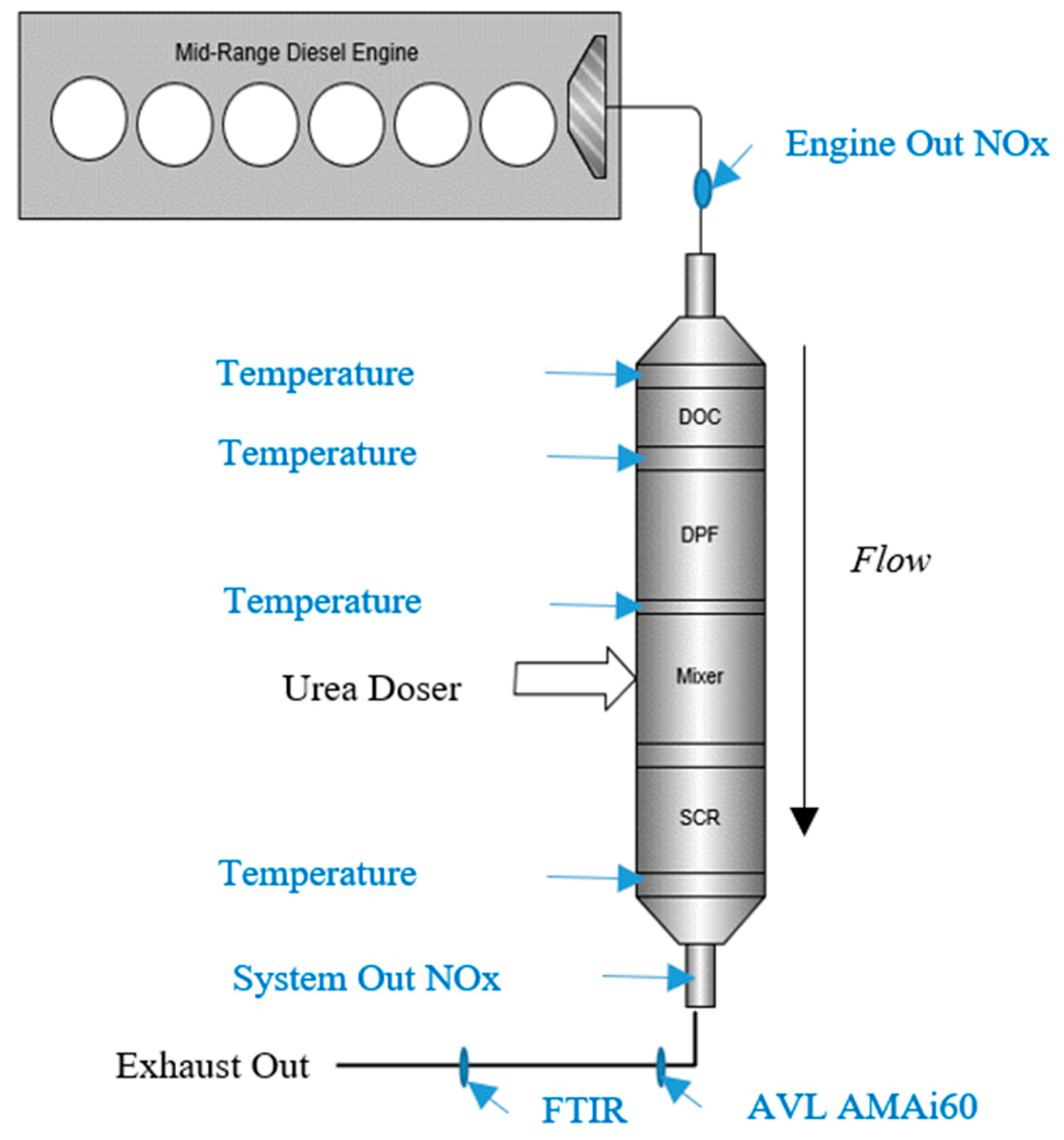

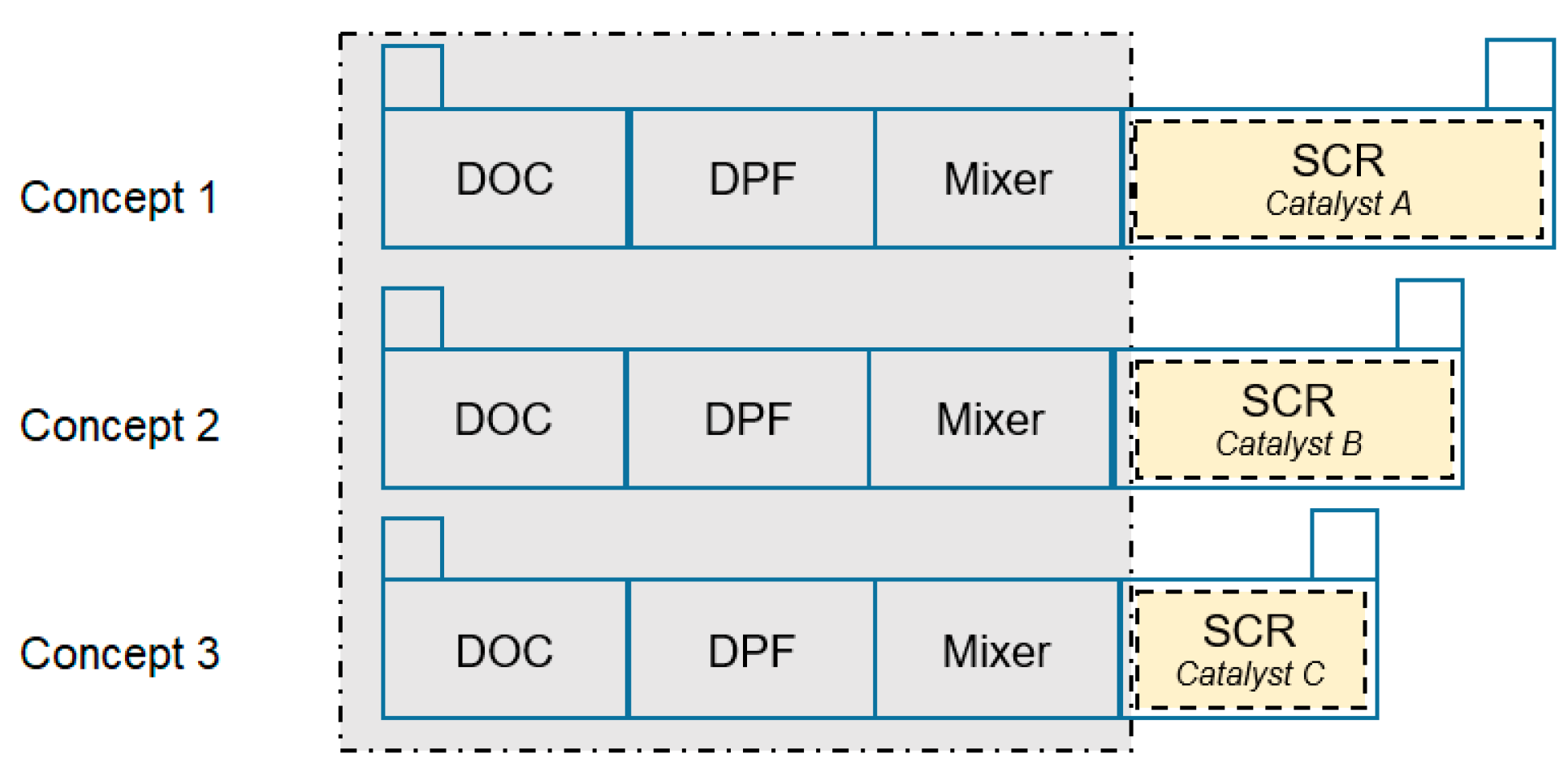
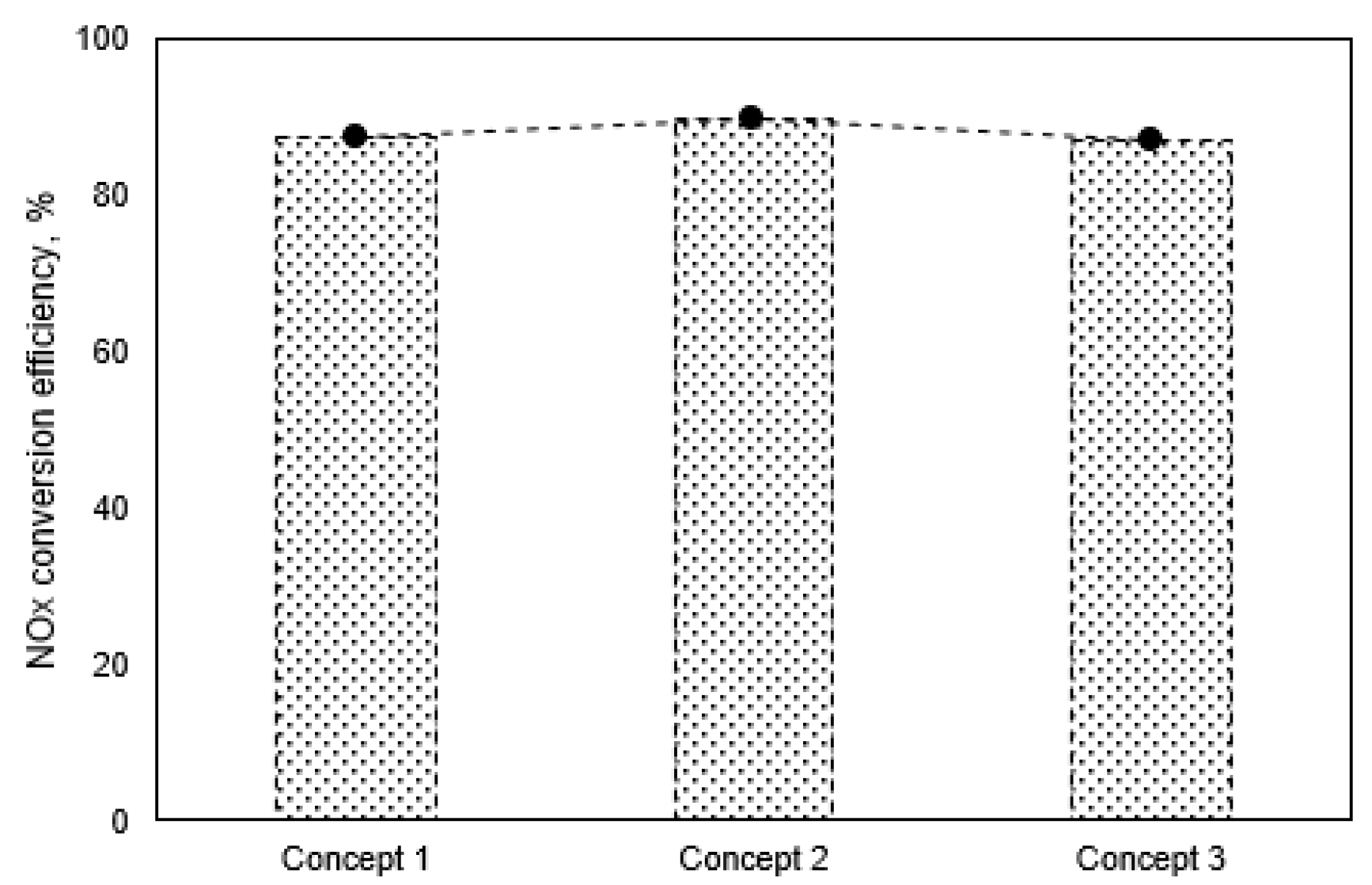
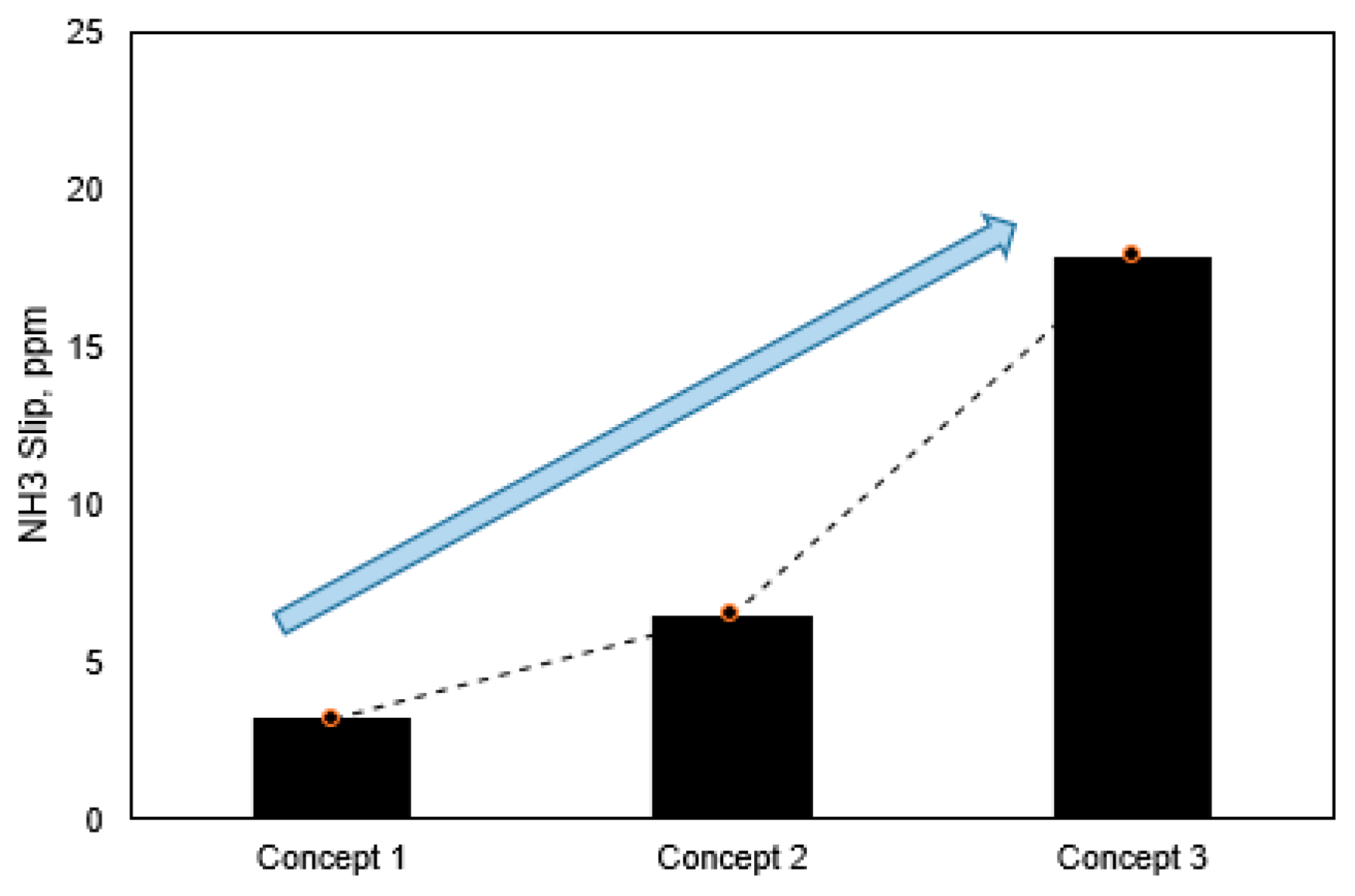

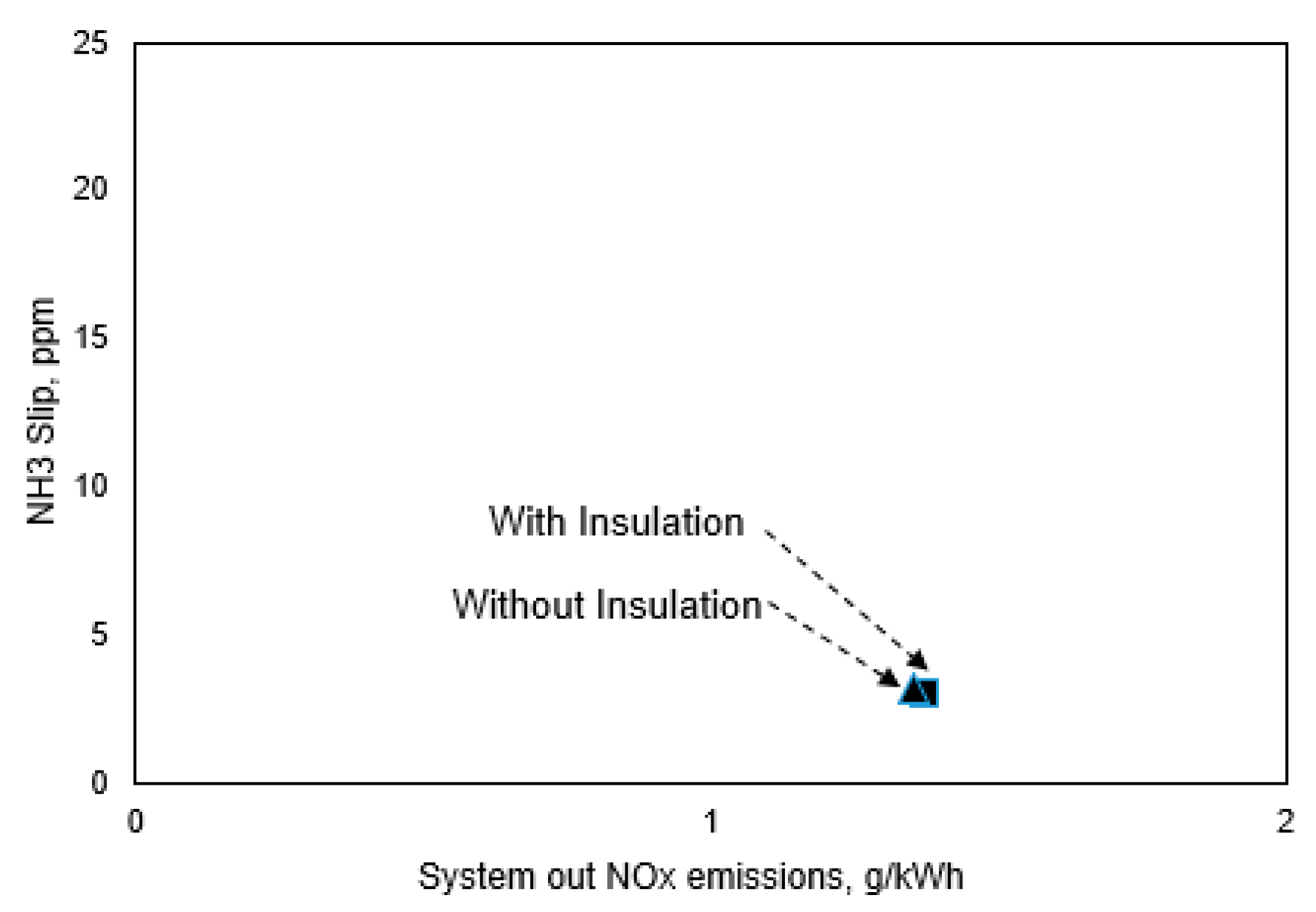
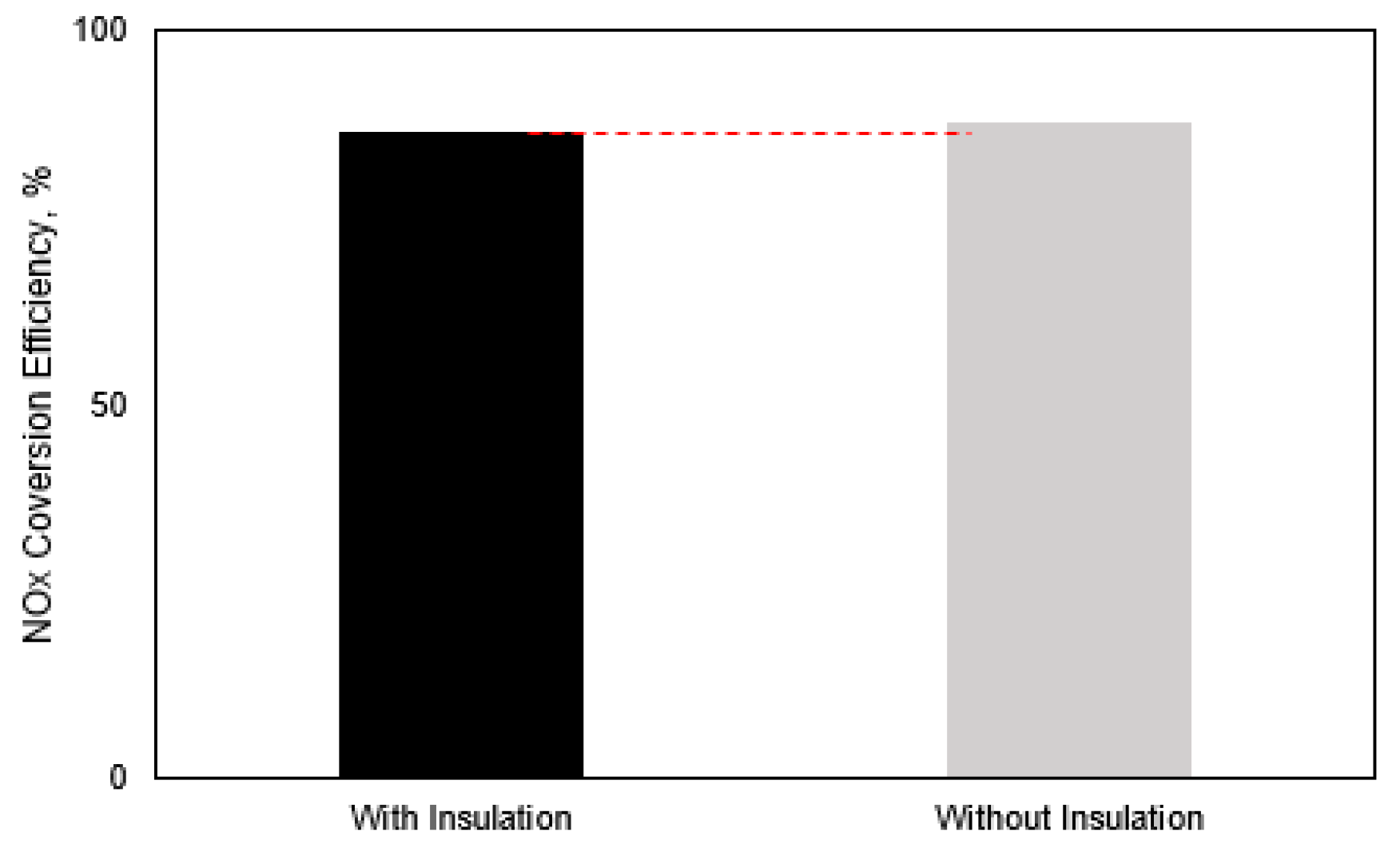
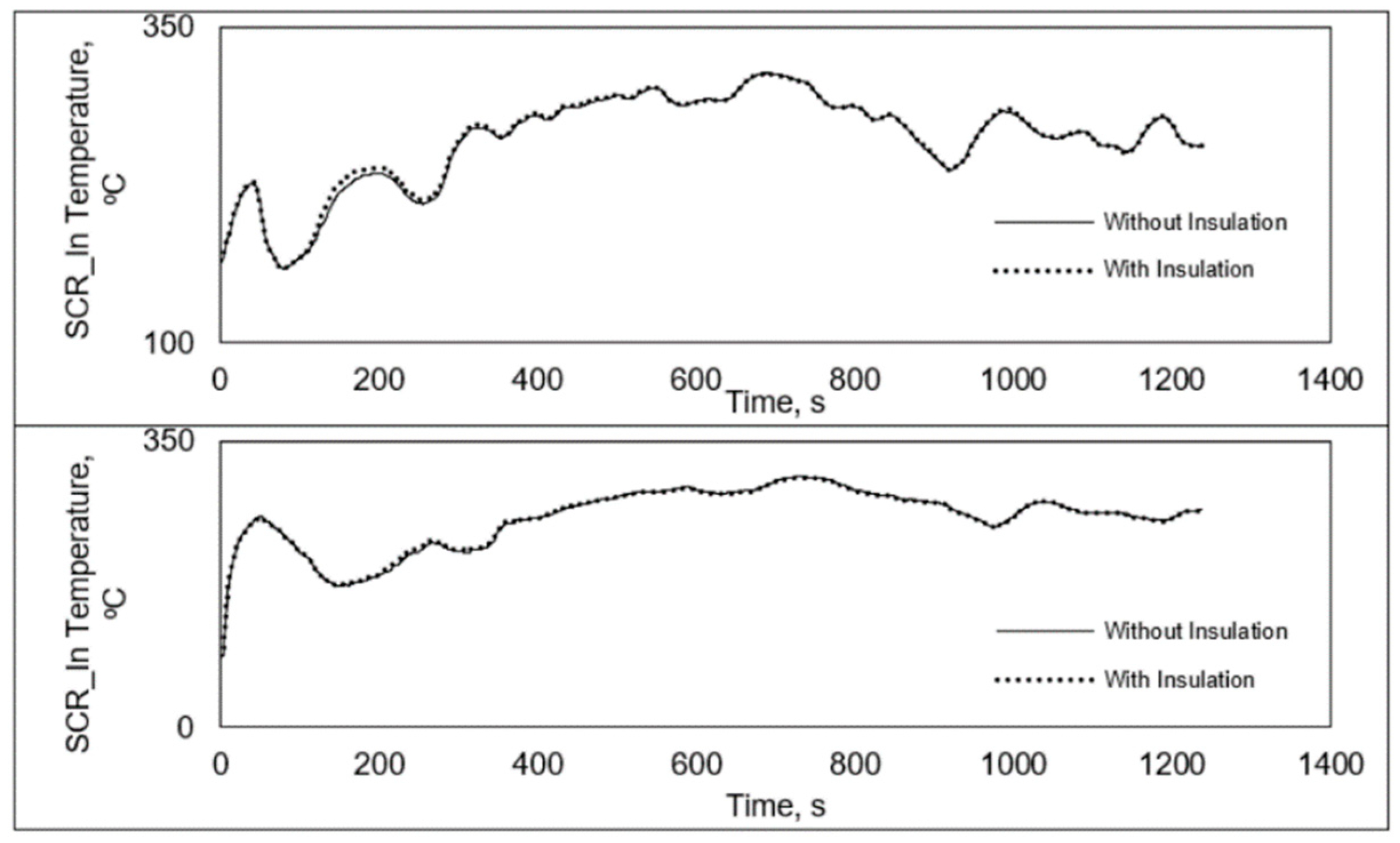

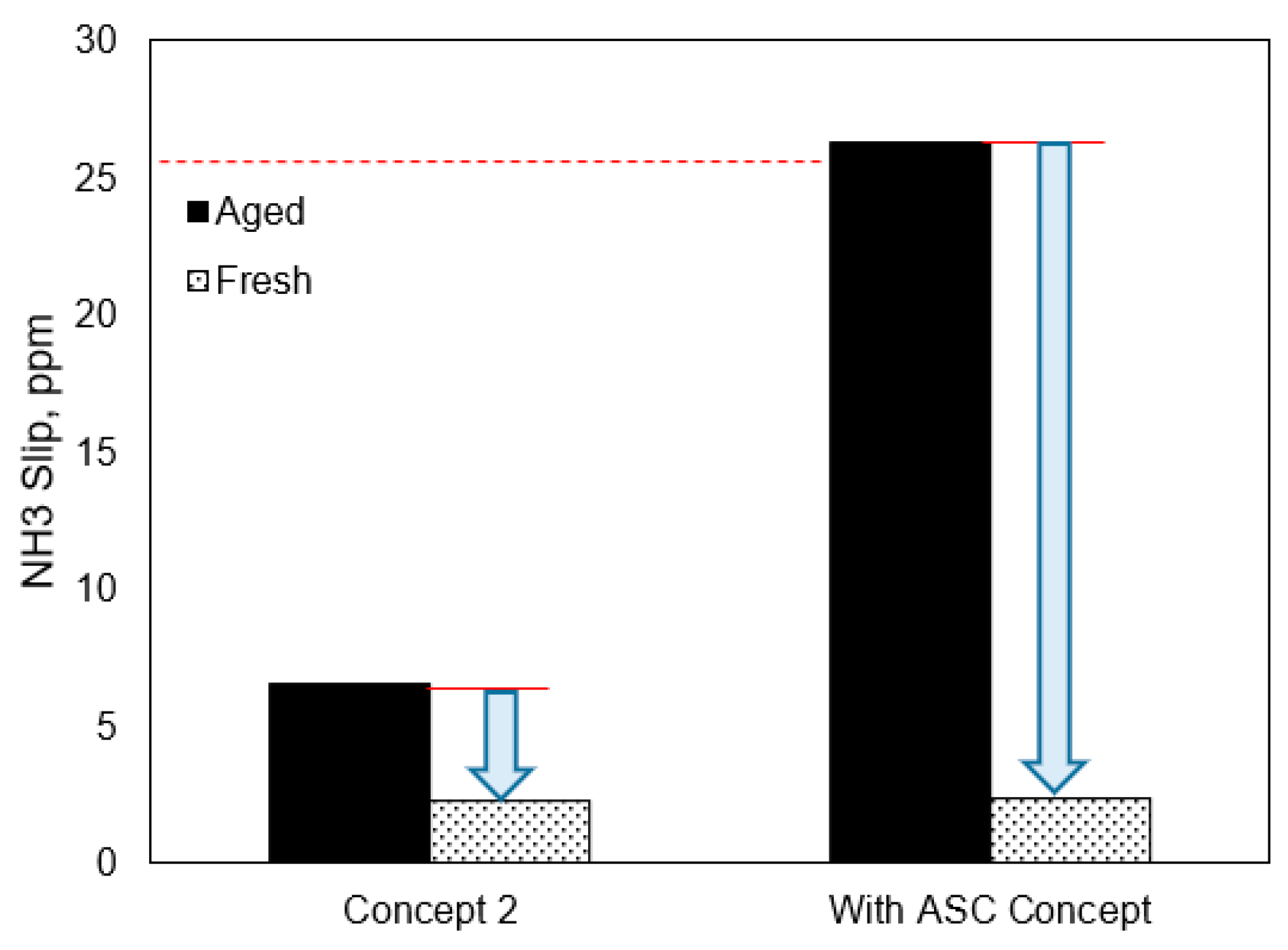

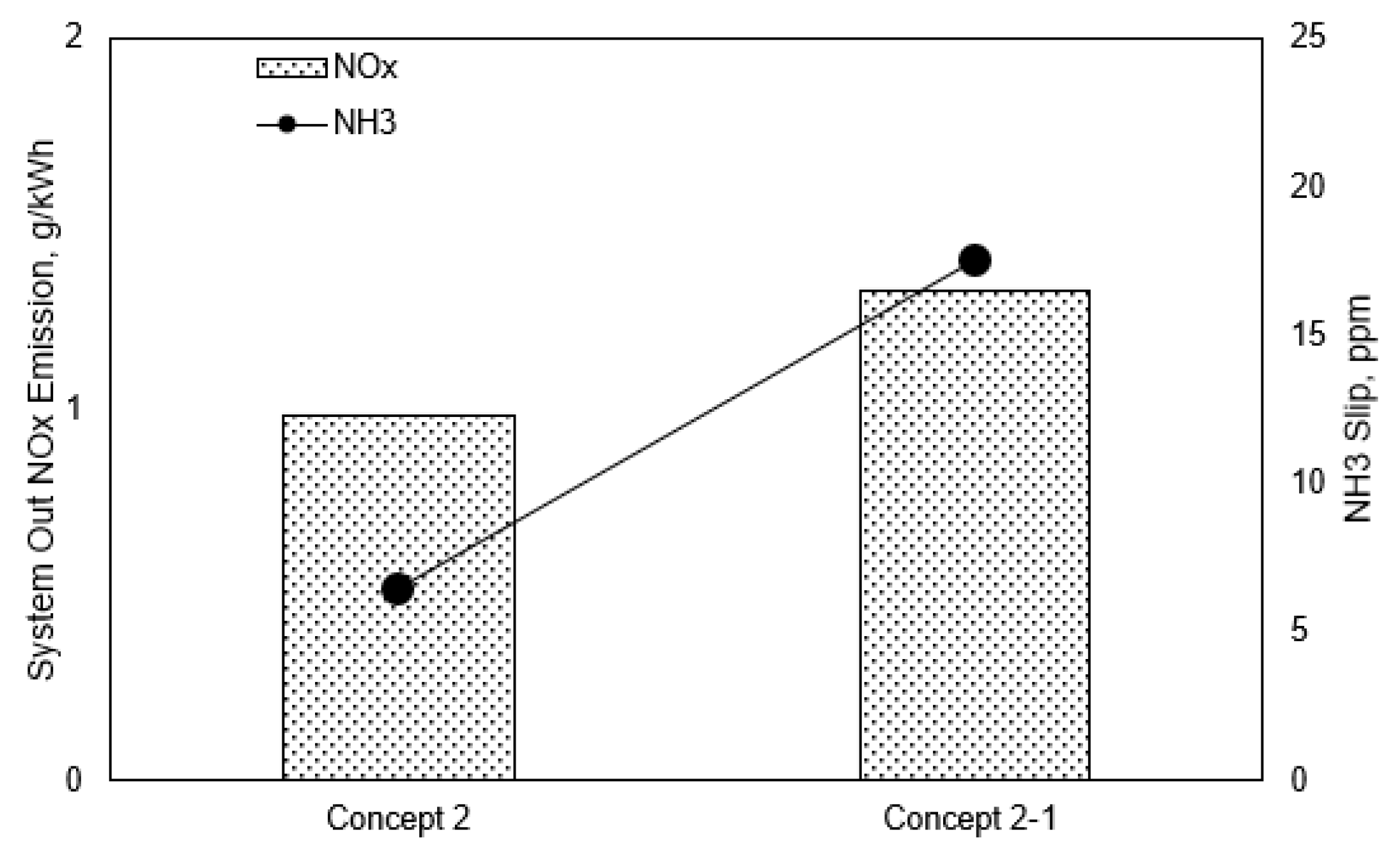
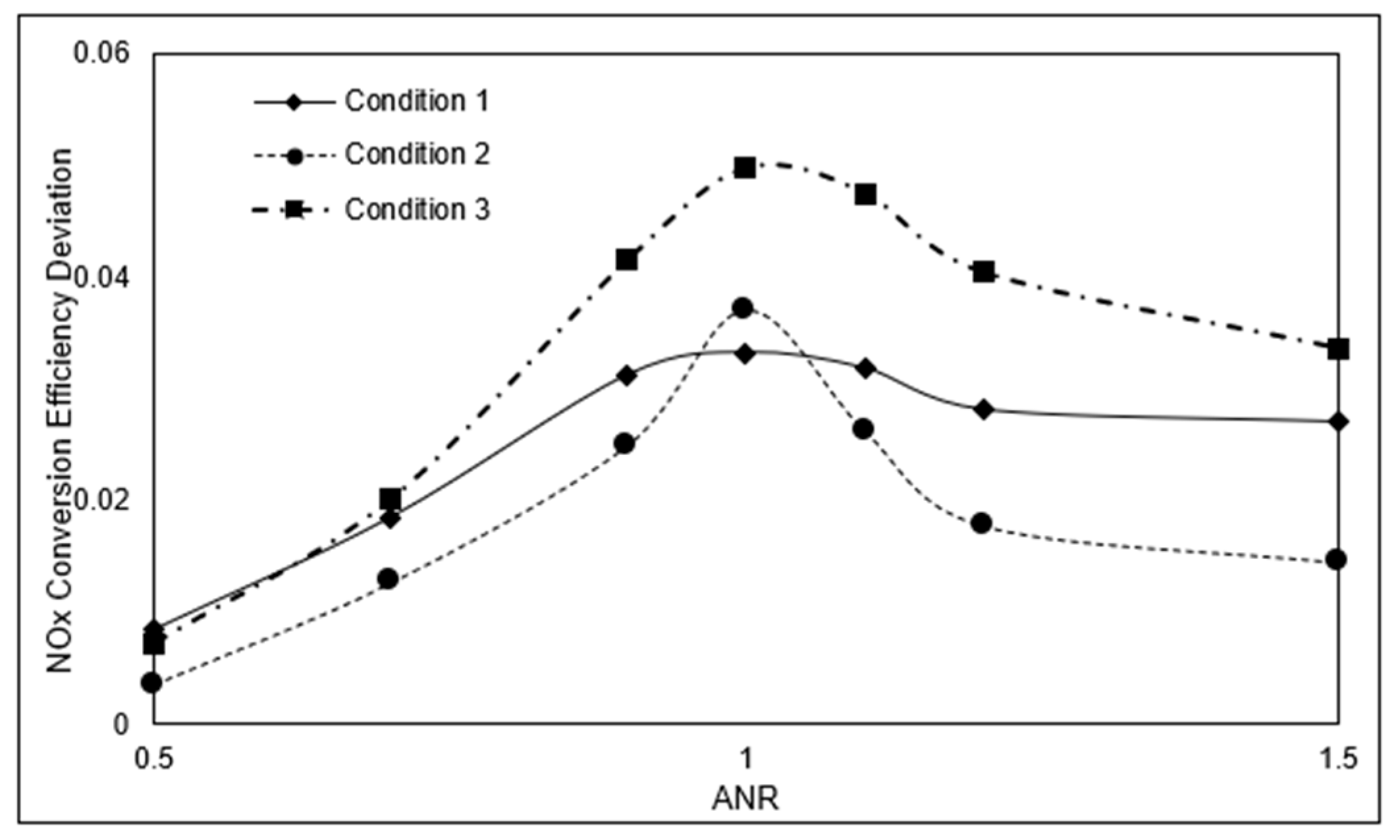
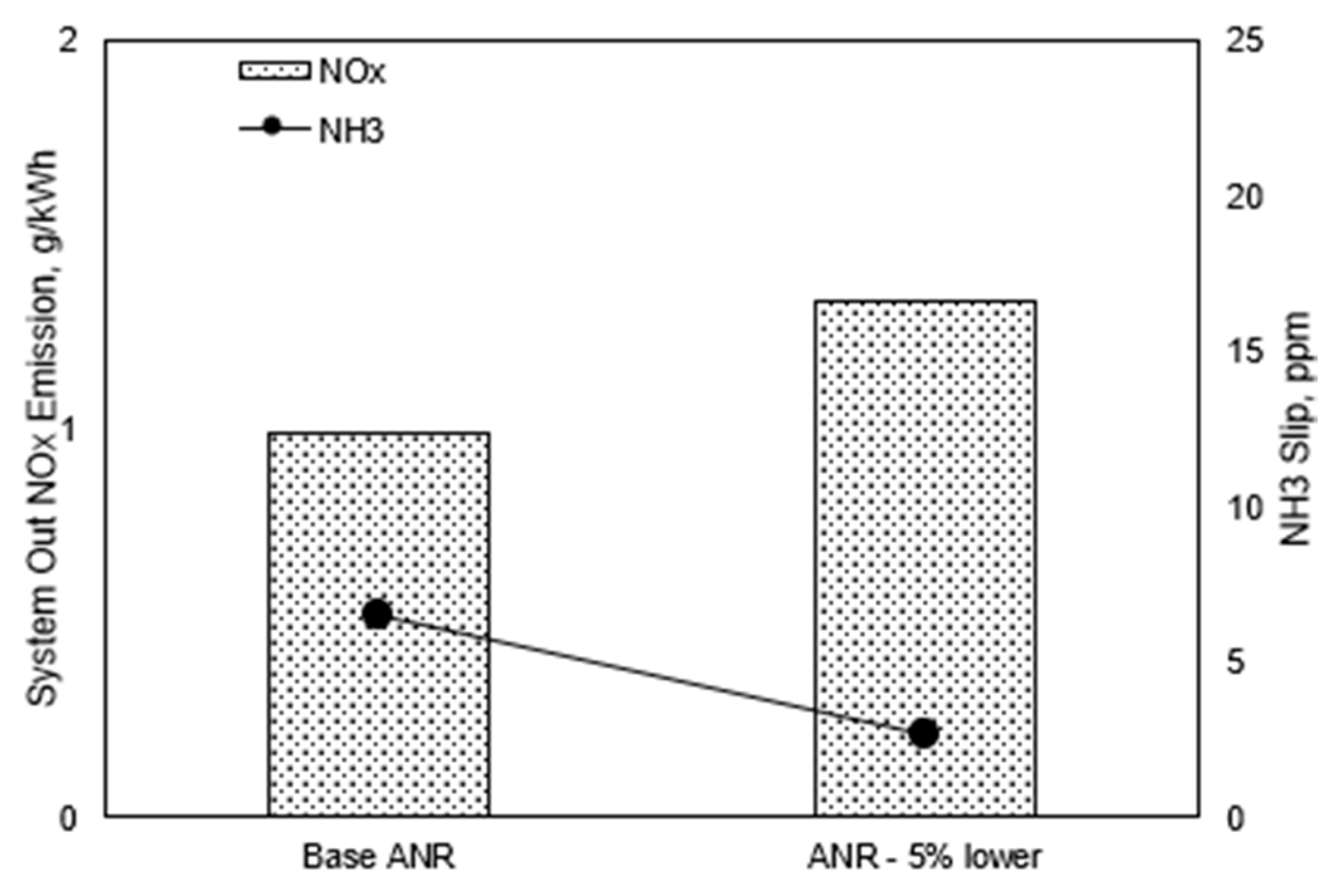
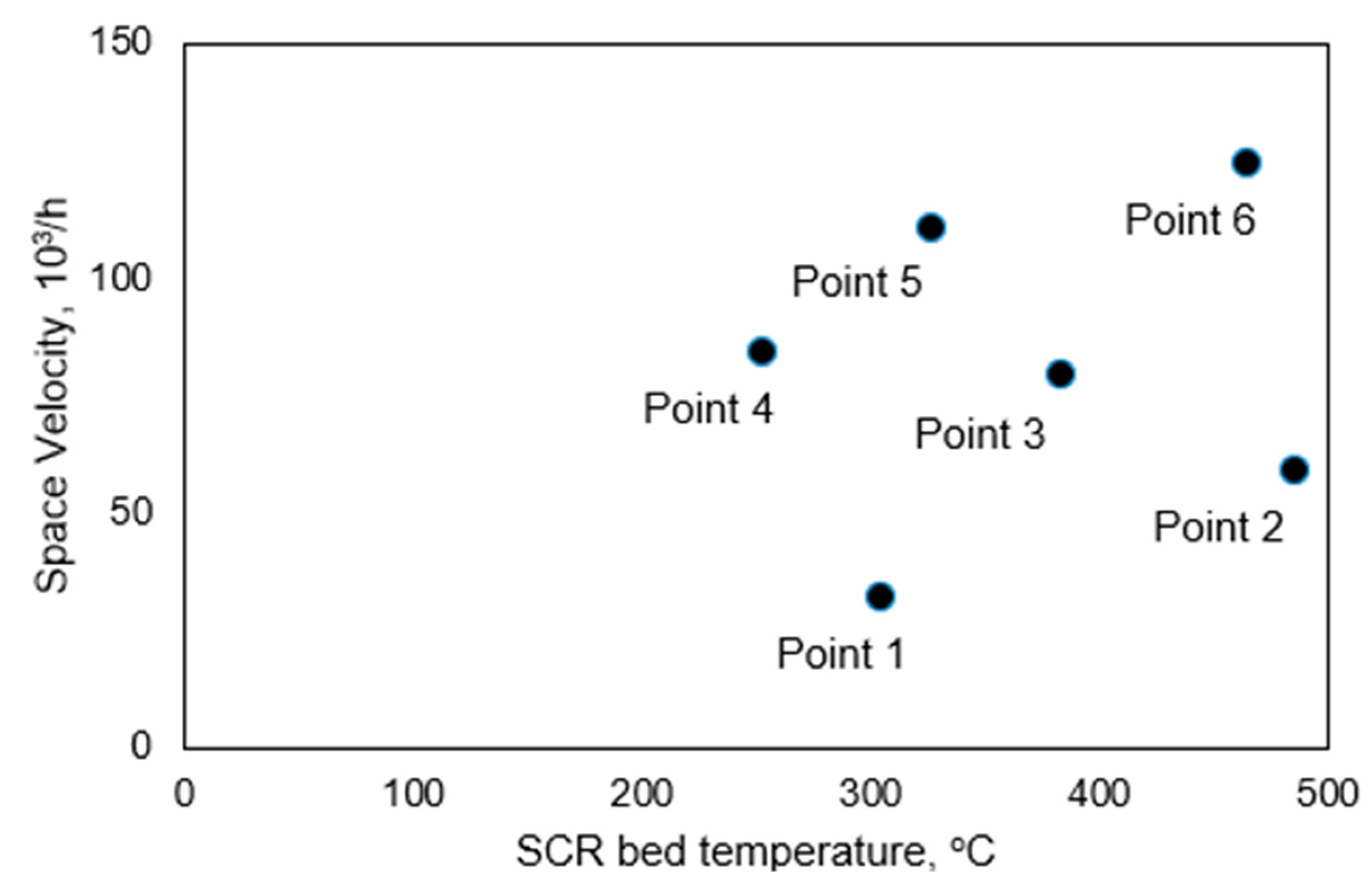
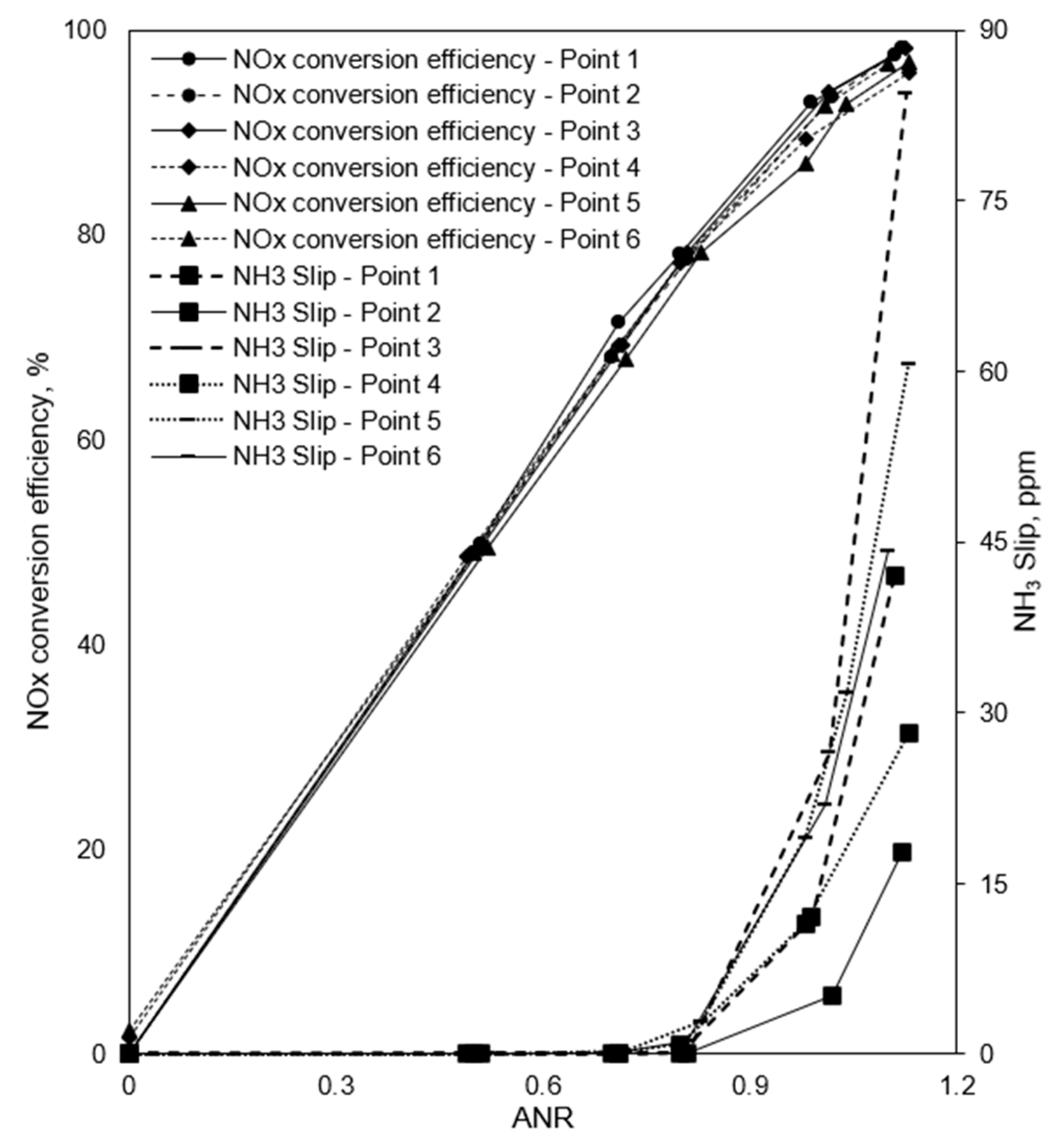
| Concept | Material | Washcoat | Diameter, (in) | Cell density, (cpsi) | ASC | Length, (in) |
|---|---|---|---|---|---|---|
| 1 | Cordierite | Cu-zeolite | 10.5 | 600 | Without | a |
| 2 | Cordierite | Cu-zeolite | 10.5 | 600 | Without | b = 0.75a |
| 3 | Cordierite | Cu-zeolite | 10.5 | 600 | Without | c = 0.5a |
| Specifications | Description |
|---|---|
| Material | Stainless steel |
| Thickness | 1.2 mm |
| Concept | Material | Washcoat | Diameter, (in) | Cell density, (cpsi) | ASC | Length, (in) |
|---|---|---|---|---|---|---|
| 2 | Cordierite | Cu-zeolite | 10.5 | 600 | Without | 0.75a |
| 2–1 | Cordierite | Cu-zeolite | 10.5 | 400 | Without | 0.75a |
| Condition | Space Velocity, (103/h) | SCR Bed Temperature, (°C) |
|---|---|---|
| 1 | 260 | 80 |
| 2 | 390 | 110 |
| 3 | 320 | 110 |
© 2020 by the authors. Licensee MDPI, Basel, Switzerland. This article is an open access article distributed under the terms and conditions of the Creative Commons Attribution (CC BY) license (http://creativecommons.org/licenses/by/4.0/).
Share and Cite
Xie, L.; Jiang, G.; Qian, F. Experimental Research on Aftertreatment SCR Sizing Strategy for a Nonroad Mid–Range Diesel Engine. Energies 2020, 13, 4462. https://doi.org/10.3390/en13174462
Xie L, Jiang G, Qian F. Experimental Research on Aftertreatment SCR Sizing Strategy for a Nonroad Mid–Range Diesel Engine. Energies. 2020; 13(17):4462. https://doi.org/10.3390/en13174462
Chicago/Turabian StyleXie, Lu, Guozhang Jiang, and Feng Qian. 2020. "Experimental Research on Aftertreatment SCR Sizing Strategy for a Nonroad Mid–Range Diesel Engine" Energies 13, no. 17: 4462. https://doi.org/10.3390/en13174462





